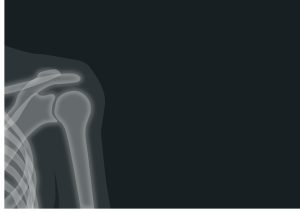The shoulder is a delicate balance between stability and flexibility. Part of the shoulder complex, the glenohumeral joint, has the largest range of motion in the body. Our shoulders sacrifice their stability for that range of motion.

The shoulder consists of several joints.
Acromioclavicular Joint
The acromioclavicular joint is a joint between the shoulder blade (scapula) and the collarbone (clavicle). Where these two bones meet is the only physical articulation holding the arm onto the body. On your body, you can feel this joint by placing your left hand on the front of your right shoulder then raising your arm. You should feel the collarbone rock and roll under your fingers. In the image below, it is indicated by the arrow labeled (1).

Glenohumeral Joint
The glenohumeral joint is visualized in the image above, labeled (2).
This joint is what most people think of when they refer to their shoulder. When you think of the proportions, it is almost equivalent to a baseball sitting on a golf tee. The glenohumeral joint provides us with the most range of motion in the shoulder complex.
Scapulothoracic Joint
The scapulothoracic joint is probably the most overlooked part of the shoulder complex. Visualized in the image below, this joint refers to the relationship between the shoulder blade and the rib cage. As the arm is brought away from the side, the shoulder blade has to depress and rotate in order for the glenohumeral joint to have space to move.
Put it all together…
When these three joints are considered as a whole, they make up the shoulder complex. The shoulder is an intimate relationship between these joints, mobility in the cervical spine (neck), and balance in over twenty one muscles.
It’s no wonder that injuries to the shoulder are some of the most complicated and frustrating to rehabilitate. It is important to seek out a provider who has experience working with this joint and understands its anatomy well.
Some common injuries associated with the shoulder include:
- Dislocation
- Multiplanar Instability
- Bursitis
- Tendonitis
- Labral Tears
- Chronic Tendinitis
- Impingement Syndrome
- Biceps Tendon Tears
- Rotator Cuff Injury
- etc.
A Delicate Balance
One of the most important messages that I have learned from the shoulder is that an ounce of prevention is worth a pound of cure- as cliche as that sounds! By ensuring that your cervical spine, thoracic spine, and the shoulder joint are moving in a balanced and healthy way, you can prevent many painful shoulder conditions.
Please seek out a healthcare professional such as a Chiropractor, Physical Therapist, Massage Therapist, or Sports Medicine Specialist to evaluate your personal movement patterns for imbalances.


please suggest a healthy shoulder exercise for people above 50 yrs
LikeLike
Hi! There are many excellent and safe exercises for all ages. However, it is important to be assessed by a health care professional to determine any restrictions or precautions you need to take based upon your own personal health history. I get many clients started with elastic bands to train good mechanics into the upper body and especially the shoulder.
Here are some links to other articles that can give you some ideas of what to ask your doctor!
Fit at Any Age
Building Muscle Over 50
LikeLike